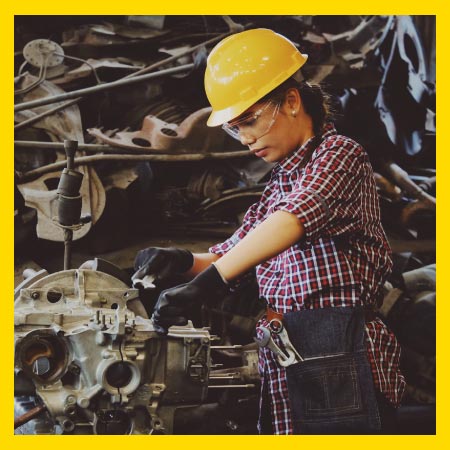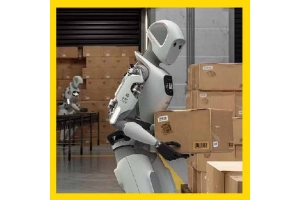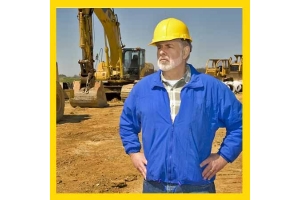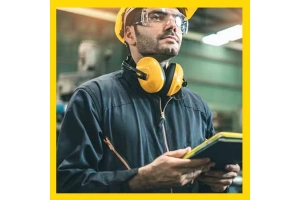Currency
February 28, 2022

How do employers monitor the health and safety of personnel without encroaching on their privacy and productivity? You can’t ask them to stop every so often to weigh in, participate in tests or interact with monitoring tools — that would take time away from their work. What’s more, how do you ensure they’re wearing the proper protective gear at all times and also check that they’re utilizing safety protocols and utilities appropriately? The answer lies with wearable devices.
Safety wearables enable management teams to remotely evaluate safety, ergonomics and environmental conditions. For example, maybe a worker hasn’t realized the surrounding temperature is climbing dangerously fast. An automated system will ping alerts to the employee and a remote operator who can make sure they get to safety. That’s just one example of how the technology can be used, among a host of benefits.
The use of safety wearables to mitigate workplace risk and disaster is becoming more commonplace, and for good reason. How are safety wearables making work sites safer? What are some use cases of the technology out in the real world?
Wearable technology will mostly improve workplace safety by reporting real-time data, namely related to health vitals, behaviors and environmental details. A smartwatch might measure heart rate, body temperatures and hydration and then report those details to a remote system controlled by machine learning and AI. If those vitals dip to dangerous levels, the network would take action alerting the worker and administrators, potentially saving lives in the process. It could also deliver critical reminders, like when it’s time to take a break, get some water or step away from a dangerous task.

These nuanced measurements can create a lot of opportunities regarding health and safety. It stretches far beyond tried and true statistics, as well. Everything is on the table, from body stats and movement indicators to environmental hazards. What’s more, wearable devices come in many forms, including smart glasses powered by augmented reality technology and personal protective gloves with integrated sensors.
It can even be implemented in existing machinery. Mini uses AR technology, called Mini Augmented Vision, to increase the field of view in its rather limited vehicles. The smart glasses provide useful information, like when another car is in a blind spot or how close to a curb it is while parking. It shows how the technology and safety wearables can be leveraged to guide and encourage while leaving users in full control. Imagine this same technology inside forklifts, construction equipment and heavy machinery.
Other ways wearable technology can improve workplace safety include implementing highly effective training. VR and AR headsets can be used to properly train new candidates in real working conditions without risks or danger. Employees get valuable hands-on experience without actually being put in the field when they’re at their most vulnerable.
The same technology can be used to deliver practical information in the field. Imagine construction workers who are shown potential fall or site hazards as they navigate a project site. Health care professionals could be warned of potential risks as a sort of play-by-play, thanks to wearable glasses.
The applications are not just for extreme conditions or risky environments, either. Workers who spend most of their day seated at a desk could receive sedentary alerts, encouraging them to get up and move. Others could be asked to use proper posture while sitting or lifting heavy items in a warehouse. An employee wearing an exoskeleton, which bears the weight of heavy and physical loads, is better protected from musculoskeletal disorders and injuries.
It’s beneficial to posit and suggest, especially with something with so much potential like safety wearables. However, the best example of any new technology is always an actual use case. How are they currently being leveraged by the workforce?
Most injuries can be prevented with better awareness and care. The Strongarm Industrial Athlete is a proactive injury prevention wearable that vibrates when a worker is moving in a way that elevates their risk. It collects data like ergonomic movements and stress factors to provide direct feedback on a worker’s health and safety while carrying out physical tasks. It can help them form smarter and healthier habits while working, reducing injuries and downtime.
Other wearables are being used specifically for cardiac monitoring, whether the goal is to keep an eye on the wearer’s heart rate or to help with potential ailments, such as arrhythmias or cardiovascular disease. The information can also be used to further research on the related disease.
Technicians repairing equipment and machines at Coca-Cola’s bottling plants utilize smart glasses to share their perspectives with remote experts, who provide further guidance. It allows the specialists to aid in repair and maintenance without traveling to the site, saving time and money. Similar technology is leveraged by Pfizer’s researchers to better understand complex protein structures. They can virtually explore molecules from every angle in a digital environment.
Safety wearables are nonintrusive, even in the case of something substantial, like an exoskeleton. They can be easily removed, and when it’s time for workers to go home, they can be secured on-premises. Smartwatches, body trackers, glasses, headsets, and bodysuits are all potential forms of wearables, yet there are many more possibilities. The technology can also be embedded inside vehicles and equipment.
Wearables make it possible to embed small sensors inside a tool handle to measure heart rate, fatigue and body temperatures and send alerts when something is awry. The point is to monitor and protect workers, not hinder their success.
There may be concerns about how the data is collected, utilized and stored. There are privacy and data issues, especially as it pertains to cybersecurity. It would be easy for the information to fall into the wrong hands. While that’s not necessarily a reason to slow growth and adoption, it’s certainly something that should be properly planned for and dealt with.
Nevertheless, it’s clear already, as early as adoption is, that safety wearables will play a huge role in the future of the modern workplace.
Safety wearables enable management teams to remotely evaluate safety, ergonomics and environmental conditions. For example, maybe a worker hasn’t realized the surrounding temperature is climbing dangerously fast. An automated system will ping alerts to the employee and a remote operator who can make sure they get to safety. That’s just one example of how the technology can be used, among a host of benefits.
The use of safety wearables to mitigate workplace risk and disaster is becoming more commonplace, and for good reason. How are safety wearables making work sites safer? What are some use cases of the technology out in the real world?
The obvious
Wearable technology will mostly improve workplace safety by reporting real-time data, namely related to health vitals, behaviors and environmental details. A smartwatch might measure heart rate, body temperatures and hydration and then report those details to a remote system controlled by machine learning and AI. If those vitals dip to dangerous levels, the network would take action alerting the worker and administrators, potentially saving lives in the process. It could also deliver critical reminders, like when it’s time to take a break, get some water or step away from a dangerous task.

These nuanced measurements can create a lot of opportunities regarding health and safety. It stretches far beyond tried and true statistics, as well. Everything is on the table, from body stats and movement indicators to environmental hazards. What’s more, wearable devices come in many forms, including smart glasses powered by augmented reality technology and personal protective gloves with integrated sensors.
It can even be implemented in existing machinery. Mini uses AR technology, called Mini Augmented Vision, to increase the field of view in its rather limited vehicles. The smart glasses provide useful information, like when another car is in a blind spot or how close to a curb it is while parking. It shows how the technology and safety wearables can be leveraged to guide and encourage while leaving users in full control. Imagine this same technology inside forklifts, construction equipment and heavy machinery.
The not so obvious
Other ways wearable technology can improve workplace safety include implementing highly effective training. VR and AR headsets can be used to properly train new candidates in real working conditions without risks or danger. Employees get valuable hands-on experience without actually being put in the field when they’re at their most vulnerable.
The same technology can be used to deliver practical information in the field. Imagine construction workers who are shown potential fall or site hazards as they navigate a project site. Health care professionals could be warned of potential risks as a sort of play-by-play, thanks to wearable glasses.
The applications are not just for extreme conditions or risky environments, either. Workers who spend most of their day seated at a desk could receive sedentary alerts, encouraging them to get up and move. Others could be asked to use proper posture while sitting or lifting heavy items in a warehouse. An employee wearing an exoskeleton, which bears the weight of heavy and physical loads, is better protected from musculoskeletal disorders and injuries.
Real-world examples of safety wearables
It’s beneficial to posit and suggest, especially with something with so much potential like safety wearables. However, the best example of any new technology is always an actual use case. How are they currently being leveraged by the workforce?
Most injuries can be prevented with better awareness and care. The Strongarm Industrial Athlete is a proactive injury prevention wearable that vibrates when a worker is moving in a way that elevates their risk. It collects data like ergonomic movements and stress factors to provide direct feedback on a worker’s health and safety while carrying out physical tasks. It can help them form smarter and healthier habits while working, reducing injuries and downtime.
Other wearables are being used specifically for cardiac monitoring, whether the goal is to keep an eye on the wearer’s heart rate or to help with potential ailments, such as arrhythmias or cardiovascular disease. The information can also be used to further research on the related disease.
Technicians repairing equipment and machines at Coca-Cola’s bottling plants utilize smart glasses to share their perspectives with remote experts, who provide further guidance. It allows the specialists to aid in repair and maintenance without traveling to the site, saving time and money. Similar technology is leveraged by Pfizer’s researchers to better understand complex protein structures. They can virtually explore molecules from every angle in a digital environment.
Safety wearables are nonintrusive
Safety wearables are nonintrusive, even in the case of something substantial, like an exoskeleton. They can be easily removed, and when it’s time for workers to go home, they can be secured on-premises. Smartwatches, body trackers, glasses, headsets, and bodysuits are all potential forms of wearables, yet there are many more possibilities. The technology can also be embedded inside vehicles and equipment.
Wearables make it possible to embed small sensors inside a tool handle to measure heart rate, fatigue and body temperatures and send alerts when something is awry. The point is to monitor and protect workers, not hinder their success.
There may be concerns about how the data is collected, utilized and stored. There are privacy and data issues, especially as it pertains to cybersecurity. It would be easy for the information to fall into the wrong hands. While that’s not necessarily a reason to slow growth and adoption, it’s certainly something that should be properly planned for and dealt with.
Nevertheless, it’s clear already, as early as adoption is, that safety wearables will play a huge role in the future of the modern workplace.









